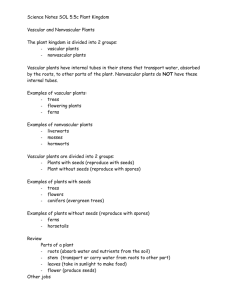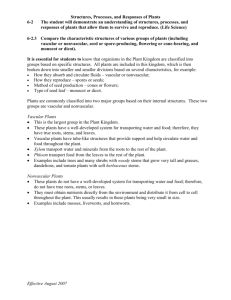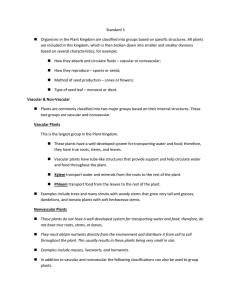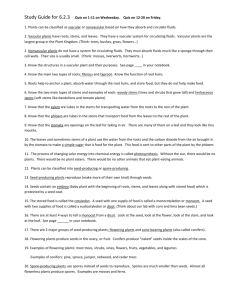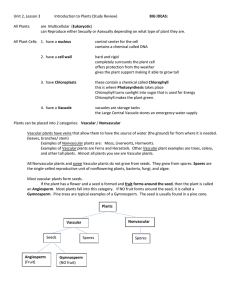Nonvascular Plants
advertisement
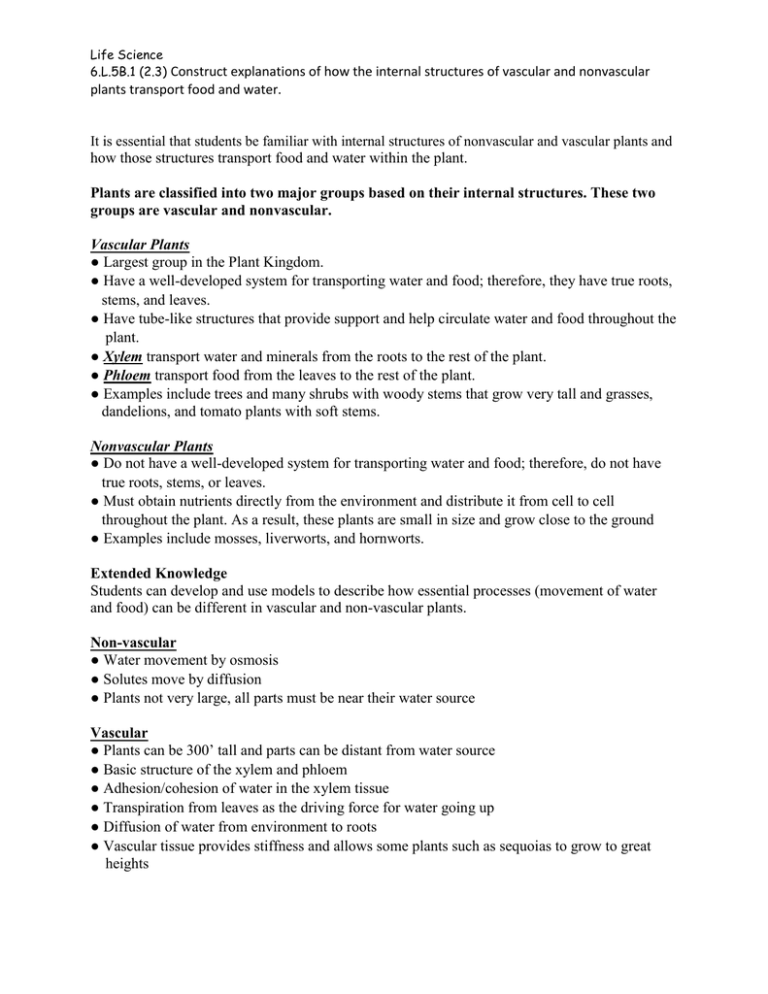
Life Science 6.L.5B.1 (2.3) Construct explanations of how the internal structures of vascular and nonvascular plants transport food and water. It is essential that students be familiar with internal structures of nonvascular and vascular plants and how those structures transport food and water within the plant. Plants are classified into two major groups based on their internal structures. These two groups are vascular and nonvascular. Vascular Plants ● Largest group in the Plant Kingdom. ● Have a well-developed system for transporting water and food; therefore, they have true roots, stems, and leaves. ● Have tube-like structures that provide support and help circulate water and food throughout the plant. ● Xylem transport water and minerals from the roots to the rest of the plant. ● Phloem transport food from the leaves to the rest of the plant. ● Examples include trees and many shrubs with woody stems that grow very tall and grasses, dandelions, and tomato plants with soft stems. Nonvascular Plants ● Do not have a well-developed system for transporting water and food; therefore, do not have true roots, stems, or leaves. ● Must obtain nutrients directly from the environment and distribute it from cell to cell throughout the plant. As a result, these plants are small in size and grow close to the ground ● Examples include mosses, liverworts, and hornworts. Extended Knowledge Students can develop and use models to describe how essential processes (movement of water and food) can be different in vascular and non-vascular plants. Non-vascular ● Water movement by osmosis ● Solutes move by diffusion ● Plants not very large, all parts must be near their water source Vascular ● Plants can be 300’ tall and parts can be distant from water source ● Basic structure of the xylem and phloem ● Adhesion/cohesion of water in the xylem tissue ● Transpiration from leaves as the driving force for water going up ● Diffusion of water from environment to roots ● Vascular tissue provides stiffness and allows some plants such as sequoias to grow to great heights Life Science 6.L.5B.1 (2.3) Construct explanations of how the internal structures of vascular and nonvascular plants transport food and water. Seed-producing Seed-producing plants are plants that reproduce through seeds. Seed plants make their own seeds. Seeds contain the plant embryo (the beginnings of roots, stems, and leaves) and stored food (cotyledons) and are surrounded by a seed coat. From those seeds, new plants grow. There are two major groups of seed-producing plants: cone-bearing plants and flowering plants. Spore-producing Spore-producing plants are plants that produce spores for reproduction instead of seeds. Spores are much smaller than seeds. Almost all flowerless plants produce spores. Examples include mosses and ferns. Flowering Plants Flowering plants differ from conifers because they grow their seeds inside an ovary, which is embedded in a flower. The flower then becomes a fruit containing the seeds. Examples include most trees, shrubs, vines, flowers, fruits, vegetables, and legumes. Cone-bearing Plants Most cone-bearing plants are evergreen with needle-like leaves. Conifers never have flowers but produce seeds in cones. Examples include pine, spruce, juniper, redwood, and cedar trees. Monocot A seed with one food storage area is called a monocotyledon, or monocot. Flowers of monocots have either three petals or multiples of three. The leaves of monocots are long and slender with veins that are parallel to each other. The vascular tube structures are usually scattered randomly throughout the stem. Examples include grass, corn, rice, lilies, and tulips. Dicot A seed with two food storage areas is called a dicotyledon, or dicot. Flowers of dicots have either four or five petals or multiples of these numbers. The leaves are usually wide with branching veins. The vascular tube structures are arranged in circular bundles. Examples include roses, dandelions, maple, and oak trees. .
